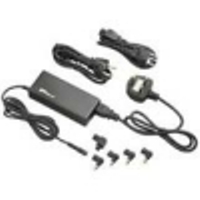 An AC Adapter is essentially an external power supply unit that derives its power from a mains power supply and converts that current and voltage to that required by the portable device. Having an external AC Adapter means that the device it is designed to provide power to, does not have to have an onboard power supply, but merely the capability to receive the power.
An AC Adapter is essentially an external power supply unit that derives its power from a mains power supply and converts that current and voltage to that required by the portable device. Having an external AC Adapter means that the device it is designed to provide power to, does not have to have an onboard power supply, but merely the capability to receive the power.
The early AC Adapters were referred to as linear power supplies that used a transformer to reduce the mains voltage of between 110-240 Volts to that required by the portable device. A lot of the earlier AC Adapters were fairly large and heavy for their size due to the fact that they contained all the circuitry for a transformer. In fact their weight was such that their weight was difficult to support directly from a wall outlet. They generated a lot of heat and their output voltage could vary without the addition of a linear voltage regulator.
Switched Mode Power Supplies (SMPS) became the next evolutionary step, because they rectify the voltage to a much higher voltage, and through a switching circuit, they produce an output current at the required level. Because of the higher frequencies involved, the transformers used with SMPS were much more compact and lighter than their counterparts. Another advantage of the SMPS is the fact that it can operate over a much wider range of voltages. I remember an early Sony VAIO that had a huge heavy ac adapter, it would hardly fit in my laptop bag!
Whenever a laptop is to be packed away for transportation, the ac adapter is removed and can, in some instances be lost or mislaid. I shudder to think of how many mobile phone adapters I have left in hotel rooms over the years, after having charged my phone. This has conspired to create a very large market for replacement ac adapters. Manufacturers use different connectors, so an AC adapter, for example designed for a Dell laptop might well not fit a Toshiba laptop. Also, the voltage requirements for one manufacturer’s laptop might be different to that of a competitor. This has resulted in a number of AC adapter manufacturers designing universal ac adapters to fit a wide range of laptops that require a different connector. Some even have a range of output voltage settings to suit whichever brand of laptop it is required to power. Some of these designs incorporate four-way or 6-way connectors , while others come with a number of interchangeable tips.
So, it is important when choosing a replacement ac adapter, and in particular a universal ac adapter that you check to ensure that:
1. It has the correct sized plug or plugs to match your laptop or laptops.
2. The input and output AC and DC voltages match those where you are intending to use the device.
3. The current supplied by this ac adapter meets the requirements of your laptop.
Most of the recent universal AC adapters are of the switched-mode power supply type and will ensure you have a more reliable output voltage, even under variable load conditions. The other important point to note is that they will generally be small and light, although if you choose an AC adapter model with interchangeable tips, they you will have additional items to carry in your laptop bag.
In the UK, Origin Storage manufacture a range of Universal Power Adapters designed for use with a number of different manufacturers range of Laptops such as Dell, Acer, Sony and Toshiba. In my opinion they are well made and offer good value for money.
This article on Universal AC Adapters was written by David Christie, MD at NSTUK Ltd, Website: http://www.ipexpress.co.uk .
